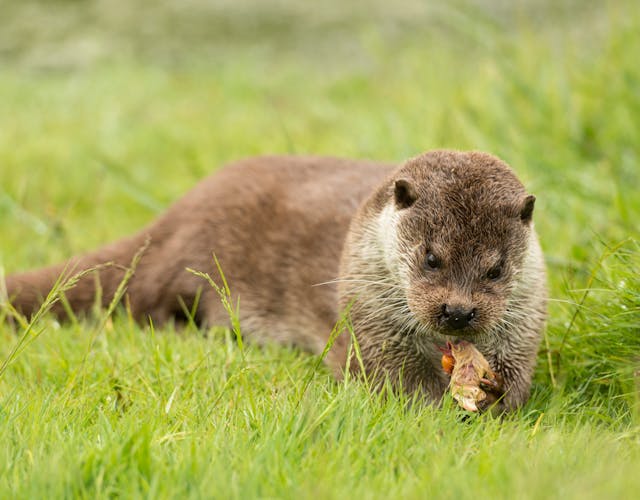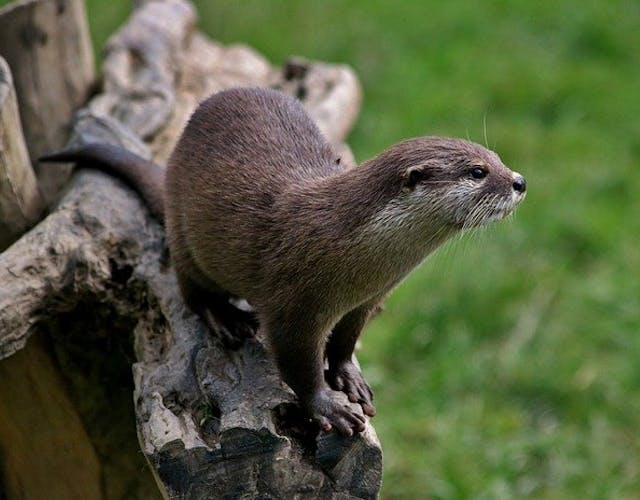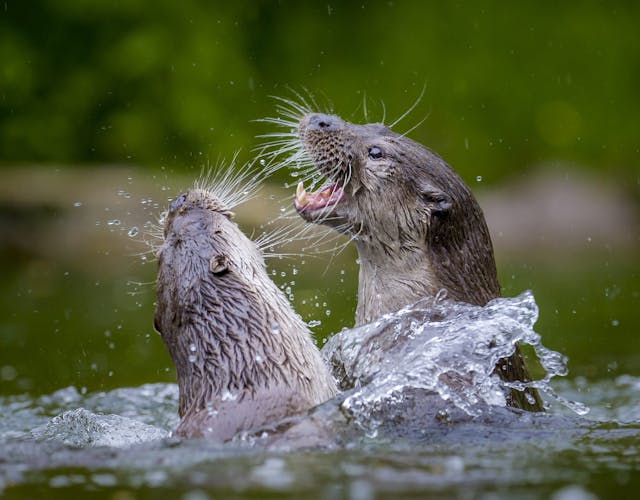European otter
In 1988 the last wild otter died in the Netherlands as a roadkill. Because of hunting, the disconnect between living areas and bad water quality the number of otters had decreased already dramatically up till then. Now the water is clean again and this beautiful animal is back in the Netherlands. The otter is the ambassador for clean water.

Since 2002 otters have been released in the Netherlands. The re-introduction project made a part of the original habitat again suitable for the otter. In 2020 about 450 otters lived in our country. This shows that the quality of our nature has improved considerably, because the otters have multiplied and found new areas to live. Cleaner water, more fish and water plants and redesigning of the river banks (with a gradual change from water to land and rich vegetation) make the otter feel at home again here.
In Nature Park Lelystad the organization “Het Flevo-landschap” takes care of otters that cannot survive in the wild anymore.
Name: European otter Species: Lutra lutra Family: Mustelidae (weasel family) Area: Europe, Asia en North America Length: 1 tot 1,25 meter Weight: 6 tot 12 kg Diet: fish, river crayfish, frogs and birds

Predator and champion swimming
The otter is a predator. He eats mainly fish, but he also samples a water bird. He is thus at the top of the feeding chain. From small to large, from stomach to stomach: every water animal is being eaten by a larger water animal, with the otter as the last link.
The otter lives along the banks of rivers, brooks and lakes and can swim and dive very well. In clear water he hunt guided by his eyes, in cloudy water guided by his whiskers. This way he can sense the movements of his prey.
The otter eats in general everything he finds in and around the water, from large insects to mice and rats. With his strong teeth he can easily break bones. He brings small fish ashore between his teeth, larger fish between his front paws.

A life in the water
Perfectly adapted. A streamlined body. The body of an otter is long and slim. Eyes, ears and nose are aligned and hardly stick out. The round tail is pointed at the end : the short, strong feet have webs between the toes. He moves effortless in the water.
Under the dark brown, fatty upper fur with long guard hairs is a thick underfur of down hairs with an insulating layer. He has small pieces of skin around nose an ears, that keep the water out while diving.

Otter marks
The otter marks his territory with spraints: oblong excrements with rests of undigested food, strongly smelling of fish. These are placed often well visible for other otters and can be found on little hills, on stones, fallen trees and under bridges.
At banks you can find eating marks like fish heads, although otters mostly eat their prey completely.
A foot print can easily be recognized, five small toes with webs between the toes (1 foot cushion and 5 toe cushions).
When you see a small path. That could be an otter exchange, a definite well used path used by the otter to get from one area of water to the next.

Extensive living area/territory
The otter is in nature a shy animal and often lives alone. In larger nature areas you can see him sometimes in the day time. He rests in a hole in dense bank vegetation. The otter is active at night.
The territory of an otter can be 7 till even 15 km. They mark this area with feces with a distinct aroma. At night an otter can cover large distances along the banks and sometimes has to cross roads. Otters don’t like to swim under bridges or through tunnels in an area that they do not know well (yet). Manmade otter passages help the animals to travel safely along the banks without having to cross roads. Otters are regularly killed by road traffic. Therefore, also in the province of Flevoland, safe passages are needed to prevent otters from becoming victims of traffic.
Only during the mating season male and female are together for a short time. The female gives birth to 2 to 3 pups that she takes care of as a single parent. After 2-3 month they can swim. After about a year they are independent and have to look for their own territory.
An otter is a good swimmer, but rather than swimming under a bridge, an otter will cross a road. Using a manmade scaffolding under a bridge, the otter can pass under the road. Also a tunnel may be useful. In the otter area in the Nature park Lelystad you can find such a passage.
Within their territory otters use multiple hiding places, otter holts. These are often natural holes, dry and free of draught, with one or more entrances and exits. The otter can safely rest here and can also use the holt to give birth to the pups. The otters in Nature park Lelystad have several manmade otter holts in their living area.
Good to know! - The otter is a signal species: when the otter is thriving, many other species will thrive as well, for example birds, fish and dragon flies. - The otter normally stays under water for 10 to 40 seconds, but can hold his breath for up to 80 seconds. - The otter is a real carnivour. Fish is the staple of his diet, but he also samples frogs and birds. - The otter fur has up to 80,000 hair on an area as small as your thumb nail. Humans have only up till 50,000 hairs on their heads. - The territory of an otter is an area of about 15 to 25 km with a lot of water
